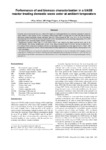Performance of and biomass characterisation in a UASB reactor treating domestic waste water at ambient temperature

Ver/
Use este enlace para citar
http://hdl.handle.net/2183/13658Coleccións
- Investigación (FCIE) [1260]
Metadatos
Mostrar o rexistro completo do ítemTítulo
Performance of and biomass characterisation in a UASB reactor treating domestic waste water at ambient temperatureAutor(es)
Data
1998-07Cita bibliográfica
Ruiz I, Soto M, Veiga MC, Ligero P, Vega A, Blázquez R. Performance of and biomass characterisation in a UASB reactor treating domestic waste water at ambient temperature. Water SA. 1998;24(3):215-22.
Resumo
[Abstract] Domestic waste water from the city of A Coruña (NW Spain) was treated anaerobically in a laboratory-scale upflow anaerobic sludge blanket (UASB) digester, at 20°C, at hydraulic retention times (HRTs) of longer than 24 h, the COD and SS removal efficiencies remained practically constant and higher than 85%. When reducing the HRT from 24 to 5 h, the COD removal decreased from 85% to 53% and the SS removal from 89% to 63%. The methane recovered in the biogas ranged from 25% to 30% of the influent COD, increasing slightly with the operational time. Methanogenic activities greater than 0.1 g CH4-COD·g-1VSS·d-1 were found for the sludge from the lower part of the UASB digester. The average methanogenic activity of the sludge decreased from 0.32 at the start-up to about 0.03 g CH4-COD·g-1VSS·d-1 at the end of operation, while the average sludge concentration was in the range of 8 to 10 g VSS·l-1. The amount and the methanogenic activity of the developed anaerobic sludge appeared to be the main efficiency-limiting factor of the UASB performance. The removal efficiencies were increased by about 5% when the UASB digester was used in combination with a completely mixed sludge digester (CMSD) system for the external digestion and stabilisation of the accumulated solids into the UASB. This also led to the increase of the biomass concentration and uniformisation of the UASB sludge bed, but the average methanogenic activity remained low.
Palabras chave
Biodegradation
Waste water
Anaerobic digestion
Methane
Waste water
Anaerobic digestion
Methane
Versión do editor
ISSN
0378-4738





